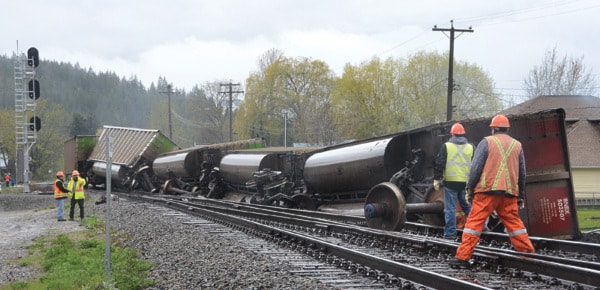Both sets of train tracks are back in operation after train cars loaded with coal derailed Monday morning in Canoe. Cleanup of the dumped dark debris, however, is expected to be finished today or early next week.
The derailment occurred on April 30 at 5:30 a.m. Ten cars at the rear of a 124-car westbound train carrying coal went off the tracks, with three cars dumping their load just before the 50th Street railway crossing. One set of tracks was opened late Monday afternoon.
CP Rail spokesperson Kevin Hrysak wouldn’t speculate on the cause of the derailment, but said an investigation is ongoing.
“These investigations can take anywhere from two weeks to upwards of a year before they come back with a determination,” says Hrysak. “So at the present moment it’s still under investigation.”
Hrysak noted there were no injuries and there was no risk to the surrounding community. Salmon Arm Fire Chief Brad Shirley said Monday that representatives from the Ministry of Environment were expected to investigate because the train knocked over a fire hydrant, and water from it flowed into Shuswap Lake. Hrysak says it is standard procedure for MOE to be notified, and he confirmed Wednesday that no coal was found to have made it into the lake.
City of Salmon Arm staff shut down water to the hydrant about 6 a.m. This left residents on the north side of the tracks, along the foreshore, without water until the scene was cleaned up later that day.
Fire crews from Salmon Arm and Canoe remained onsite throughout the morning to monitor the situation, as the derailment also impacted a hydro line, temporarily knocking out power, and also broke open a natural gas meter.
Among places affected by the power outage was the city’s water treatment plant. Rob Niewenhuizen, the city’s director of engineering and public works, said staff were initially quite concerned about how long the outage would last, so a notification was issued asking residents to conserve water. However, the power was restored by 9 a.m., causing no problems with water treatment.
People living in foreshore cabins north of the tracks on 75th were without water for the longest, Niewenhuizen said, because water was shut off to the hydrant that was sheared off by the derailment. Sewage treatment was also unaffected. Three lift stations pumping sewage in the vicinity of the derailment were set up with generators, while two vacuum trucks were used to suck up sewage and deposit it in the lines closer to the downtown sewage treatment plant.
Hrysak said CP’s first responders and operational personnel were on site as well, assessing the situation while assuring all necessary precautions were taken before cleanup commenced.
“We’re co-operating with all of the agencies involved,” said Hrysak. “The cause of the incident has yet to be determined, but safety is our top priority so we will be conducting a full investigation into not only the cause, but what led to it as well.”
